
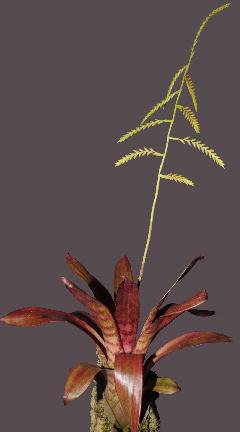
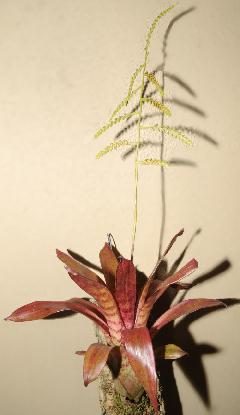
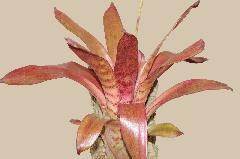

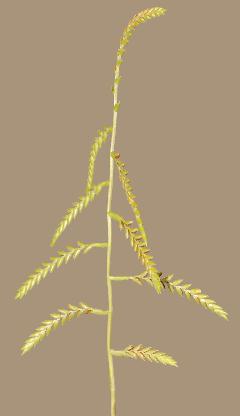
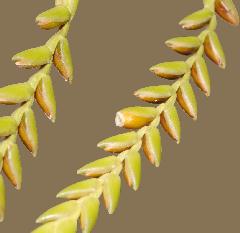
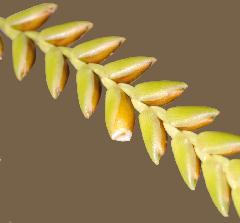
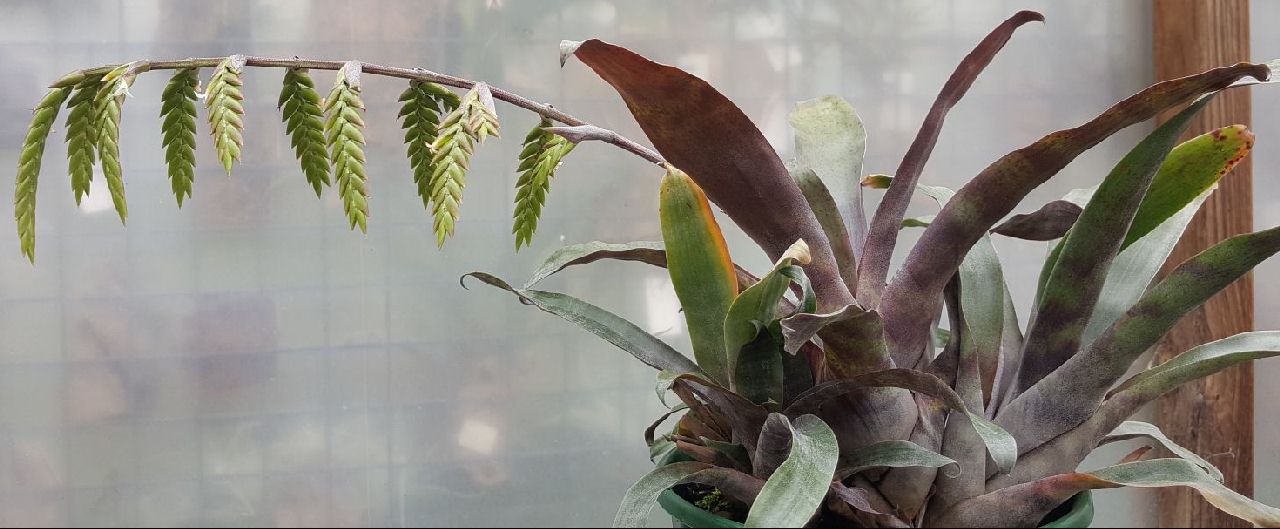

Racinaea spiculosa (Grisebach) MA Spencer & LB Smith Phytologia 74:157. 1993
Tillandsia spiculosa Grisebach, Nachr. Ges. Wiss. Goett. "1864": 17. 1865.
Description from S&D 1032-36
Plant stemless, to 8 dm high.
Leaves rosulate, 3-4 dm long, obscurely punctulate-lepidote, often irregularly purple-spotted or cross-barred;
Sheaths relatively large, broadly ovate, dark brown;
Blades ligulate, rounded-apiculate or acute, 2-4 cm wide.
Scape erect, glabrous, often much exceeding the leaves;
Scape-bracts narrowly elliptic, rounded-apiculate or short-caudate, about equaling the internodes or the upper ones slightly shorter, punculate-lepidote.
Inflorescence tripinnate or bipinnate, lax; axes soon glabrous;
Primary bracts narrowly ovate, apiculate, much shorter than the axillary branches;
Spikes linear, often curved, densely 24-flowered, to 9 cm long, 6-9 mm wide, spreading, usually long-stipitate with sterile bracts at the base.
Floral bracts broadly ovate, 5-9 mm long, equaling or slightly exceeding the sepals, convex, ecarinate, coriaceous, nearly or quite even, scantly lepidote or glabrous.
Sepals broadly elliptic, even, glabrous, asymmetric;
Petals orange or yellow, acute;
Stamens included;
Ovary globose, the style short.
Capsule slenderly cylindric, to 22 mm long.
Tillandsia spiculosa has certain geographic trends but intermediates are so numerous that it is impossible to maintain T. triticea and T. micrantha as species or T. palmana as even a variety.
Key to the Varieties of Tillandsia spiculosa
1.Floral bracts (5-)6-9 mm long, mostly more than twice as long as the internodes; spikes densely flowered at least toward apex. => 2
1a.Floral bracts 4-5 mm long, mostly less than twice as long as the internodes; spikes laxly flowered at maturity. => var micrantha.
2. Leaf-blades concolorous or merely spotted; inflorescence usually tripinnate. => 3.
2a. Leaf-blades irregularly cross-banded with dark purple; inflorescence usually bipinnate. => var ustulata.
3. Branches all turned to one side (Secund) => var. stenoglossa
3a.Branches pointing in all directions => var. spiculosa.
Racinaea spiculosa var. spiculosa
Tillandsia brittoniana Baker, Handb. Bromel. 195. 1889. Type. Yungas, La Paz, Bolivia, Rusby 2852 (NY).
Tillandsia palmana Mez, Bot. lahrb. 30(Beibl. 67): 9. 1901. Type. Tonduz in Inst. Costar. 9710 (BR, US photo), La Palma, San Jose, Costa Rica, Jul 1895.
Tillandsia micrantha Baker, Bull. Torrey Club 29: 698.1902; non Baker, 1887. Type. Yungas, La Paz, Bolivia, Rusby 2852 (NY), 1885.
Tillandsia spiculosa var. palmana (Mez) L. B. Smith, Contr. Gray Herb. 89: 14. 1930.
Tillandsia lescaillei C. Wright in Sauvalle, Anal. Acad. Ci. Habana 8: 53. 1871. Treated by Zanoni et al. Moscosoa 4: 82. 1986 as a synonym of T. spiculosa var. spiculosa
Leaf-blades merely spotted or concolorous.
Inflorescence usually tripinnate;
Spikes densely flowered at least toward apex.
Floral bracts (5-)6-9 mm long, mostly more than twice as long as the internodes.
Type. Fendler 1518 (holotype GOET, US photo), Maya, Aragua, Venezuela.
Distribution Epiphytic in forest, 825-2100 m alt, Costa Rica, Panama, Republica Dominicana, Colomoia to Suriname, Bolivia and northern Brazil.
COSTA RICA: HEREDIA: Cariblanco, Rio Sarapiqui, 27 Apr 1956, Williams 19387 (EAP). SAN JOSE: San Jeronimo, Mar 1909, Biolley 17363 (US). CARTAGO: Cartago, 1901, Werckle in Inst. Costar. 16177 (US); El Muneco, Navarro, Feb 1924, Standley 33763 (US); 33781 (US); Mar 1926, Standley & Torres 51296 (US); 51784 (US); Orosi, 30 Mar 1924, Standley 39910 (US); 39918 (US); 39930 (US); Pejivalle, Feb 1926, Standley & Valerio 47229 (US); Rio Reventado, Cartago, 26 Feb 1926, Standley & Valerio 49503 (US). PANAMA. PANAMA: Campana, Allen 1878 (MO); Cerro Campana, Allen 2435 (MO). REPUBLICA DOMINICANA. BARAHONA: Monteada Nueva, Aug 1946, Howard 8466 (GH, US); 8595 (GH, US); 9 Apr 1963,Jimenez 4635 (US). COLOMBIA. MAGDALENA: Santa Marta, 1898-99, H. H. Smith 2852 (NY); Cincinnati, Santa Marta, 3 Aug 1946, Foster & Smith 1393 (GH). VALLE: La Laguna, Rio Sanquinini, Dec 1943, Cuatrecasas 15517 (F, GH); La Carbonera, Las Brisas to Albin, Oct 1946, Cuatrecasas 22238 (V ALLE). META: Sierra de la Macarena, 26 Jan 1950, Philipson, ldrobo & Jaramillo 2252 (BM); lan 1951, 1drobo & Schultes 995 (GH, US). VENEZUELA. NUEVA ESPARTA: Macanao, Bernardi 2461 (MER). SUCRE: Cerro Patao, Puerto de Hierro, 19 lul 1962, Steyermark & Agostini 91127 (US, VEN). DISTRITO FEDERAL: Agua Negra to El lunquito, 29 Dec 1936, Pittier 13832-A (US); Los Venados, Vog1 A-155 (M); Naiguata, Nov 1963, Steyermark 92013 (US, VEN); Geremba, 31 Jul 1966, Steyermark 95996 (US, VEN). ARAGUA: Rancho Grande, Teuscher 2746-51 (US); Colonia Tovar, 5 Apr 1962, Rudd 1009 (US). CARABOBO: Rio San Gian, Borburata, 28 Mar 1966, Steyermark 95230 (VEN). YARACUY: Cerro Picacho, Nirgua, 11 Mar 1967, Steyermark 97700 (VEN). F ALC6N: Sierra de San Luis, La Tabla, 17 Jul1967 , Steyermark 99008 (VEN); Montana de Paraguariba, Sierra de San Luis, 21 Jul 1967, Steyermark 99357 (US, VEN). TRUJILLO: Bocono to Guaramacal, 9 Sep 1966, Steyermark 97355 (US, VEN). MtRIDA: Merida to La Azulita, 6 Mar 1962, Bascope 28 (VEN). TACHlRA: Michelena to Boca de Monte, 28 Aug 1966, Steyermark & Rabe 96762 (VEN). BOLIVAR: Cerro Acopan, Caroni, Oct 1947, Cardona 2305 (VEN); Aprada-tepui, Aug 1953, Bernardi 790 (MER). SURINAME. Ebbatop, 15 Feb 1951, Florschutz 1465 (U). ECUADOR. NAPO: Puyo to Tena, 26 Aug 1973, Rauh 34784 (HEID). PERU. PUNO: San Gaban, Carabaya, 7 Feb 1967, Vargas 18852 (US). BRAZIL. CEARA: Serra de Maranguape, 24 Nov 1955, Lima 55-2376 (IPA).
Protologue
Tillandsia brittoniana Baker, Handb. Bromel. 195. 1889. Type. Yungas, La Paz, Bolivia, Rusby 2852 (NY).
164. T. BRITTONIANA Baker.
Leaves few in a rosette, thin, lorate, subglabrous, above a foot long, 1¼ in. broad at the middle. Peduncle above a foot long; bract-leaves small, adpressed. Panicle a foot long; spikes 20-30, 1½ -2 in. long, ¼ in. broad; lower branch-bracts an inch long; flower-bracts_oblong, 1/6 in. long. Calyx as long as the bract; sepals obtuse. Petal-blade small.
Hab. Bolivia; province of Yungas, alt. 6000 ft,, Rusby 2852! This and two following have the flowers of Pseudo-Catopsis, and the lorate leaves of Allardtia.
Synonym
Tillandsia micrantha Baker, Bull. Torrey Club 29: 698.1902
Acaulis, foliis paucis loratis tenuiter lepidotis, pedunculo foliis aequilongo, bracteis patvis adpressis, spicis pluribus lanceolatis distichis in paniculam amplam depositis, bracteis floribus oblongis obtusis, calyce bractea aequilongo sepalis obtusis.
Leaves over a foot long, .25 in, broad at the middle;
panicle a foot long, consisting of 20-30 dense distichous spikes, 1.5 – 2 in long, .25 in broad, the upper sessile, the lower peduncled; .15 in long;
petal-blade minute.
Allied to T. spiculosa Griseb. , but panicle much more compound
Yungas, 6000 ft., 1885 ( Rusby 2852) (No. 2232 is the inflorescence only of a species of Tillandsia)
Synonym
See Mez 1935
135. T. palmana Mez in Englers Bot. Jahrb. XXX. Beibl. 67 (1901) 9.
T. spiculosa var. Palmana (Mez) L. B. Smith in Contrib. Gray Herb. LXXXIX. (1930) 14.
Usque ad 0,6 m alta. Folia utriculatim rosulata, ad 0,18 m longa, medio 25 mm lata, lingulata, apice anguste rotundata acumineque imposito reflexo-crispato aucta, ex sicco maculata, appresse lepidotula, sicca haud involuta coriacea. Scapus erectus, folia duplo vel ultra superans, geacilis, vaginis paullo inflatis, dorso lepidibus perappressis cinereis, haud vel vix laminigeris, internodia exacte aequantibus vel inferioribus superantibus praeditus. Inflorescentia muitiflora, 2-pinnatim panniculata, laxa, folia longe superans; axibus glabris, rectis; bracteis primariis subercctis, dorso lepidotis, quam spicae axillares permulto brevioribus; spicis omnibus subsessilibus, suberectis, flabellatis, usque ad 14-floris, haud curvatis, usque ad 60 mm longis, ad 7 mm latis, anguste linearibus; bracteis florigeris sepala paullo sed constanter superantibus, imbricatis, coriaceis, dorso non nisi juvenilibus paullo lepidotis, laevibus, valde concavis, nec carinatis, obtusiusculis, ad 8mm longis. Flores erecti, haud secundi, sepalis liberis, asymmetricis, coriaceo-rigidis, glabris laevissimisque, 6-7 mm longis, ellipticis, late rotundatis.
Costarica: bei La Palma (Herb. inst. phys.-geogr. Costar. n. 9710 leg. Tonduz), bei Juan Vinas (Werckle), bei Cartago (Werckle n. 69, 71 et in Herb. inst. phys.-geogr. Costar. n. 16177).
Synonym
Tillandsia lescaillei C. Wright in Sauvalle, Anal. Acad. Ci. Habana 8: 53. 1871.
Desc in S&D
Treated by Zanoni et al. Moscosoa 4: 82. 1986 as a synonym of T. spiculosa var. spiculosa
Plant stemless, flowering 6-11 dm in length.
Leaves forming a basal rosette 6-10 cm thick, all erect, 25-30 cm long;
sheaths broad, elliptic, chestnut-brown, passing almost imperceptibly into the blades;
blades evenly green, sublorate, 3-4 cm wide.
Scape much surpassing the leaves, decurved;
scape-bracts membranaceous, densely and finely pale lepidote, apiculate, much shorter than the internodes and not wholly enfolding the scape.
Inflorescence pendulous at maturity, open, bipinnate and distichous, 25-55 cm long, 10-20 cm wide;
primary bracts not over 25 mm long, narrow, apiculate;
spikes linear in outline, 5-12 cm long, about 10 mm wide, with flowers closely erect and barely or not quite imbricate, often long-stipitate and bearing several sterile bracts at the base;
rhachis somewhat flexuous.
Floral bracts 7-8 mm long, about equaling the sepals, usually quite nerveless, soon glabrous, ecarinate.
Sepals asymmetric, obtuse.
Capsule cylindric, 18-23 mm long.
TYPE. C. Wright 674 in part (holotype GH), Monteverde, Oriente, Cuba, Jan Jul 1859. DISTRIBUTION. Epiphytic in thickets and forest, 840-1490 m alt, Cuba, Hispaniola, northern Venezuela.
CUBA. ORIENTE: La Gloria, Sierra Moa, Dec 1910, Shafer 8057 (K, NY, US); Loma Mensura, Sierra de Nipe, 16 May 1915, Ekman 5748 (S); La Bayamesa, Rio Oro to Rio Yao, 4 May 1916, Ekman 7133 (S); Alto de Iberia, Sierra Maestra, 12 Nov 1916, Ekman 8311 (S); Pico Turquino, Sierra Maestra, 21 Jul 1922, Ekman 14498 (S); s d, Acuna 14058 (SV); 19 May 1948,15057 (SV). HAITI. La Barriere Couchant, 17 Jul 1905, Nash & Taylor 1094 (NY); Ennery, Artibonite, 5 Feb 1926, Leonard 9559 (GH, US); Morne Tranchant to Morne Brouet, Massif de la Selle, 11 Sep 1924, Ekman H-1855 (S); Anse a Foleur, Morne Colombeau, Massif du Nord, 20 Jun 1925, Ekman H-4361 (S). REPUBLICA DOMINICANA. MONTE CRISTI: Lagunas de Cenobi, Moncion, 23 Jun 1929, Ekman H-12987 (S, US). SANTIAGO: El Pico de Igua, 15 Aug 1946, Jimenez 1280 (US); Diego Ocampo, 2 Sep 1948, Batista in Jimenez 1727 (US). LA VEGA: Constanza, 29 Oct 1947, Allard 16412 (US); 4 Dec 1947, 17483 (US). VENEZUELA. ANZOATEGUI: Rio Leon to Bergantin, 7 Mar 1945, Steyermark 61417 (VEN). FALCON: Montana de Paraguariba, Sierra de San Luis, 23 Jul 1967, Steyermark 99484 (VEN
Racinaea spiculosa var ustulata (Reitz) M A Spencer & L. B. Smith.
Tillandsia triticea Burchell ex Baker, Jour. Bot. London 26: 42. 1888. Type. Santos, Sao Paulo, Brazil, Burchell3217 (K, US photo), 1 Oct 1826.
Tillandsia parkeri Baker, Jour. Bot. London 26: 42. 1888. Type. Without locality, Guyana, Parker s n (K, GH photo).
Tillandsia viridis Baker, Handb. Bromel. 204. 1889. Type. Paranagua, Parana, Brazil, Morren Icon s n (K).
Vriesea viridis E. Morren ex Baker, Handb. Bromel. 204. 1889; nomen.
Vriesea luschnathii Mez in Martius, FI. Bras. 3(3): 555, pl. 103. 1894. Type. Without locality, Rio de Janeiro State, Brazil, Luschnath s n (B n v, destroyed ?).
Tillandsia triticea var ustulata Reitz, Sellowia 14: 108. 1962.
Leaf-b1ades irregularly cross-banded with dark purple.
Inflorescence usually bipinnate;
Spikes densely flowered at least toward apex.
Floral bracts (5-)6-9 mm long, mostly more than twice as long as the internodes.
Type. Reitz 5934 (holotype HBR), Corupa, Santa Catarina, Brazil, 2 Sep 1957.
Distribution. Epiphytic in forest, 2-1100 m alt, Colombia and Guyana to Peru, Bolivia, and southern Brazil.
COLOMBIA: NORTE DE SANTANDER: Ocafia, 20 Sep 1946, Foster 1752 (COL, GH). VALLE: La Laguna, Rio Sanquinini, Dec 1943, Cuatrecasas 15517 (F). NARINO: Rio Nembi, Barbacoas, 16 Nov 1946, Foster 2194 (GH). TRINIDAD: Mount Tocuche, 1920, Britton et al 1323 e p (NY). GUYANA. NORTHWEST DISTRICT: Anabisi River, 1922, Cruz 1357 (NY). PERU. LORETO: Cerros Campanquiz, Pongo de Manseriche, Rio Maranon, 17 Oct 1962, Wurdack 2280 (US, USM). JUNIN: San Nicolas, Pichis Trail, Jul 1929, Killip & Smith 26055 (US); Paucartambo Valley, Aug 1956, Rauh P-118 (US). BOLIVIA. LA PAZ: San Bartolome, Calisaya, Sur Yungas, 22 Jan 1939, Krukoff 10512 (GH, NY); Copacabana, Mapiri, Larecaja, Krukoff 11155 (NY). SANTA CRUZ: Yungas de San Mateo, Comarapa, Steinbach 8416 (GH). WITHOUT LOCALITY: Bang 2301 in part (F, GH). BRAZIL. BAHIA: Rio Gongogi (Grungogi), 1915, Curran 137 (US). ESPIRITO SANTO: Campinas to Vitoria, 14 Jul 1939, Foster 204 (GH); Santa Teresa, 26 Jul 1939,Foster 275 (GH, R). RIO DE JANEIRO: Petropolis, 27 Mar 1886, Glaziou 16465 (P); Teresopolis, Nov 1956, Abendroth 9 (US). SAO PAULO: Santos, 20 Feb 1875, Mosen 3494 (S); Alto da Serra, 23 Aug 1902, Edwall s n (SP); 5 Feb 1929, L. B. Smith, Hoehne & Kuhlmann 1827 (GH); 8 Nov 1938, A. Gehrt s n (SP); 19 Aug 1939, Foster 370 (GH); 371 (GH, R); Sao Vicente, 1960, Doering 23 (US); Ubatuba, 5 May 1969, A. Seidel s n (US). PARANA: Porto da Cima, 4 Nov 1908, Dusen 6975 (S); 7 Jan 1914,14605 (S); Paranagua, 5 Apr 1910, Dusen 9796 (S); 1 Sep 1939, Foster 448 (GH); cult Sep 1940, Handro s n (SP); Volta Grande, Serra do Mar, 13 Aug 1911, Dusen 12034-A (S); 12035 (S); Jacarei, 5 Apr 1914, Dusen 14694 (S); 26 Mar 1914,14755 (S); 11 Jun 1915, 17070 (GH); Morretes to Antonina, 31 Aug 1914, Dusen 15472 (S, US); near Santa Catarina boundary, Curitiba to Joinvile,Reitz 3892 (HBR); Guaratuba, 3 Feb 1952, Reitz 4274 (HBR); 21 Feb 1952,L. B. Smith & Reitz 5747 (R, RB, US); Pontal do Sul, Paranagua, 25 Sep 1967, Hatschbach 17238 (US). SANTA CATARINA: Spitzkopf, Brusque, 9 Mar 1950, Reitz 3462 (HBR); Morro da Bateia, 1950, Reitz 3595 (HBR); Joinvile, 1951,Reitz 3716 (HBR); Brusque, 1951, Reitz 3818 (HBR); 21 Mar 1951, 3949 (HBR); Corupa, 25 Apr 1951, Seidell (HBR); 24 Apr 1951, 10 (HBR); 21 Jul 1951, Reitz 4130 (HBR); 5 Feb 1952, 4229 (HBR); Piloes, Palhoca, 14 Mar 1952, L. B. Smith 6222 (R, US); without locality, Mar 1892, F. Mueller s n (K).
From Bromeliaceas by Reitz 160-163. 1983
Tillandsia spiculosa var. ustulata
Translated by Butcher
EPIPHYTIC, acaulis, flowering 0.4 m tall or more, rhizome short, almost naked.
LEAVES 8-12, well arranged in rosettes, gathered at the bottom forming a perfect ovoid cistern; SHEATH large, amplexicaul, wide oval, brown, covered on both sides with dense appressed scales;
BLADE suberect, decurved near the sheath, chartaceous-coriaceous, 30 cm long, 30 mm wide, wide linear, apex briefly acute with a fine point, reflexed and often deciduous, green on both sides, especially on the bottom, covered in dark purple spots, often confluent, on the back decked with wide stripes, dark purple, transverse almost to the apex, but less intense with obscure purple spots around the underside , scaled on both sides.
INFLORESCENCE multifloral, formed in a panicle composed of distichous spikes with 15-20 flowers, from the centre of the rosette, much surpassing it, apex erect, up to 40 cm high, 15 cm wide;
SCAPE very strong, a little scaled;
SCAPE BRACTS wide oval, acute, amplexicaul, erect, enclosing the scape, bigger than internodes, the back densely scaled, with pungent tips, recurved at apex, green (heliophytes purplish);
RACHIS glabrous, little angled, suberect, green (heliophytes purplish);
BRANCHES patent, curved, floral axis well compressed and geniculate;
PRIMARY BRACTS lanceolate, patent, similar to scape bracts;
SECONDARY BRACTS a little spaced, very distinct distichous, coriaceous, scales more towards the point, inside polished, suborbicular, wide acute or a little obtuse at the apex, margins a little wavy, very concave (not carinate) enclosing the sepals or being them 1 mm smaller, shiny, ca 7 mm long, green.
FLOWERS sessile, suberect, 8 mm long; SEPALS green, 6.5 mm long, free, coriaceous, shiny, asymmetric, with the right side developed in a large spiral curve, wide subovate, apex rounded, slightly carinate;
PETALS white at apex, light yellow at the base, 1 mm larger than the sepals, much larger than the stamens, concrescent in as wide tube at the base and narrowed at the top, only 1.5 mm free at the apex, obtuse;
STAMENS linear, narrowed at the top, smaller than the stigma and much smaller than the sepals, concrescent for 2/3 of petals height;
STAMENS 0.80 mm long, wide and chordate at the base, acute at apex and with a tip, basifixed;
GRAIN of POLLEN yellow, elliptic, with longitudinal slit;
OVARY large, ellipsoid, slightly tri-sulcate, passing suddenly to a thick style, quite small; stigma with narrow lobes and coiled, much shorter more than the stamens;
PLACENTA when fertile affixed at an internal of locules from the ground up to almost the top;
OVULES with narrow peduncle and long, elongated, with large point at apex, truncated.
CAPSULE cylindrical, 30 mm long, with 3 ridges and 3 salient longitudinals, a little contracted at the base, acute apex or with small dirty yellowish tip, dehiscent at the base;
EXOCARP dry, rugose irregularly, not separated from the ENDOCARP which is dark brown and shiny.
SEEDS brown, subfusiform, up to 2.5 mm long, acute apex, with white subsericious ca 16 mm long, on base, appendiculate with umbiliform woolly bundle.
Type - Brasil, Santa Catarina: Corupa, Reitz 5934 (02.09.1957, holotype HBR.
Common names – Gravata, bromelia, monjolinha.
Phenological data-in the region was found in flower in July, October, January, February and March; with fruit in January, March, April and November.
Ecological observations - Herb epiphytic, acaulis, 40 cm or more tall, short rhizome, leaves few 8-12, well arranged in rosettes, gathered at the base to a cistern, large amplexicaul sheaths, decurved blades, chartaceous-coriaceous, 30 cm long, 3 cm wide, margins entire, recalling the appearance of Vriesea; leaves green on both sides, covered with dark purple spots, especially below, a round form or confluent; on the back wide stripes, dark purple, transverse almost to the apex, dark-purple-tipped around the bottom side that characterize the species; inflorescence tall in the form of a bunch with distichous spikes that emerge from the center of the rosette; characteristic and exclusive to rain forest of the Atlantic coast, where it is found widely, but nevertheless discontinuous dispersal, with possibly the southern limit in the Serra do Tabuleiro in the East-Central Coast of the State of Santa Catarina. Species heliophyte or of diffused light, infrequent; as an epiphyte it grows on the branches or trunks of trees in the interior of the forests located between 30 and 500 meters altitude, mostly in the Serra do Mar.
In surveys conducted by H. P. Veloso (1952), 271 examples were examined of this species, with an average height of affixation of 13.25 metres above the ground; a maximum of 500cm³ and an average of 47cm³ of water contained in the imbrication of the leaves; 81.55% being posted on the trunks, 13.30% in branches and 5.l5% on the humus at the top of the slopes; as for the quantity of light 54.85% was diffused light and 45.15% heliophytic; regarding sociality 60.4% were grouped into 2 to 5 specimens and 37.6% occurred in isolation.
Material studied - SANTA CATARINA: BRUSQUE: Morro Spitzkopf, epifito da mata, fruto, 350m, erva com folhas de largas falxas roxas atravessadas na bainha,, 350m, R,. Reitz 3462 (09.03.1950), HBR; ibidem, perto da cidade, epifito da mata,30m, flor e fruto, R. Reitz 3818 (21.03.1951), HBR, foi redescrita por R. Reitz e desenhada por D. Fossari para esta obra; ibidem, Morro da Bateia, epifito, flor, R. Reitz 3595 (05.01.1980), HBR, foi desenhada para esta obra, por D. Fossari.
CORUPA: perto da cidade, fruto, A. Seidel 10 (25.04.1951), HBR; ibidem, folhas quase roxo-escuras, escapo, raquls e bracteas quase roxo-escuras, flor, A. Seidel 2 (21.07.1951), HBR,; ibidem. Morro do Garrafao, epifito da mata, 500m, flor, R. Reitz 4229 (05.02.1952), HBR,; ibidem, perto da cidade, flor, R. Reitz 5934 (02.09.1952), typus da var. ustulata Reitz, HBR; ibidem, perto da cidade, flor branca, H. J. Eipper s. nr. (14.02.1961), HBR,. IMARUI: Aguas Mornas, R. M. Klein & A. Bresolin 10693 (16.01.1973), FLOR, HBR,. JOINVILLE: perto da cidade, epifito da mata, 40m, fruto, R. Reitz 3716 (12.01.1951), HBR,; ibidem, Tres Barras, 30m, fruto, R. Reitz & R. M. Klein 4584 (26.07.1957), HBR.
PARANA: GUARATUBA: perto de Garuva, flor branca, H. J. Eipper s. nr. (14.02.1961), HBR,; ibidem, Estrada Joinville-Curitiba, 150m, fruto, R. Reitz 3892 (14.01.1951), HBR; ibidem, perto da cldade, flor, R. Reitz 4274 (08.02.1952), HBR; ibidem, na divisa com S. Catarlno, folha so pintada, sem listas, fruto, R. Reitz 6282 (10.11.1961), HBR.
Area of dispersal - SANTA CATARINA: municipalities of Brusque, Corupa, Joinville and Palhoca (L. B. Smith!)
BRASIL: states of Bahia, Espirito Santo, Rio de Janeiro, Sao Paulo, Parana and Santa Catarina. COLOMBIA to GUIANA and PERU and BOLIVIA.
Uses - Plant ornamental.
Endemiological note - Species with receptacle too small, water deposit may accumulate but very crowded, so temporary, and for being located in very alternating variations of relative air movement, do not have conditions to develop the larvae of mosquitoes which are the transmitters of malaria.
Of the 271 example examined by Veloso (1952), not any occurrence of mosquito larvae were found.
Synonyms from Baker 1889
Protologue
Tillandsia viridis Baker, Handb. Bromel. 204. 1889. Type. Paranagua, Parana, Brazil, Morren Icon s n (K).
204, T. VIRIDIS Baker.
Vriesea viridis E. Morren (M.D.). -
Leaves few, rosulate, lorate, thin, flexible, pale green. 3-4 in. long, ½ in. broad at the middle. Peduncle slender, shorter than the leaves. Inflorescence a lax panicle 3-4 in. long; spikes dense, simple, sessile, lower patent, 1-1½ in. long, ¼ in. broad; flower-bracts ovate, obtuse, 1/6 in. long. Calyx a, long as the bract. Capsule cylindrical, ½ – ¾ in. long.
Hab. South Brazil; island of Paranagua, Platzmann. Described from Prof. Morren's drawing, copied from one of Platzmann's. Near T. triticea and T. Parkeri.
205. T. TRITICEA Burchell ; Baker in Journ. Bot, 1888, 42,
Leaves lorate from a large ovate base, 3 in. broad, a foot long, 1½ in broad at the middle, thin, flexible, subglabrous, deltoid-cuspidate at the tip, copiously blotched with claret-purple. Peduncle slender, as long as the leaves; bract-leaves small, appressed. Panicle a foot long; spikes 10-12, arcuate, ascending, sublax, all simple, 2-3 in. long; lower branch-bracts lanceolate, 1- 1½ in. long; flower-bracts oblong, obtuse, ¼ in. long. Calyx as long as the bract; sepals obtuse. Petals not seen. Capsule-valves lanceolate, 3/4 in. long.
Hab. Brazil ; province of St. Paulo , Burchell 3217. Collected in 1826.
206. T. PARKERI Baker in Journ. Bot. 1888, 42.
Leaves lorate from an ovate base 1½ in. broad, a foot long, an inch broad at the middle, flexible, subglabrous. Peduncle slender; upper bract-leaves small, adpressed, scariose. Panicle 6-8 in. long; branches about 6, shortly peduncled, erecto-patent; spikes moderately dense, 1-2 in long; flowers erecto-patent ; flower-bracts ovate-oblong, subobtuse, ¼ in. long. Calyx nearly as long as the bract; sepals obtuse. Capsule under an inch long.
Hab. British Guiana, Parker! Nearly allied to T. triticea.
Synonym
Vriesea luschnathii Mez in Martius, FI. Bras. 3(3): 555, pl. 103. 1894. For detail see jpeg
Racinaea spiculosa var micrantha (Baker) M A Spencer & L. B. Smith
Tillandsia micrantha Baker, Jour. Bot. London 25: 303. 1887.
Tillandsia chinchicuana Harms, Notizbl. Bot. Gart. Berlin 10: 578. 1929. Type. Playoncito, Chinchicua, Sierra Nevada de Santa Marta, Magdalena, Colombia, Schulze 1521 (B, F photo 792, 11488), 1928.
Spikes laxly flowered at maturity.
Floral bracts 4-5 mm long, mostly less than twice as long as the internodes.
Type. Fendler 818 (holotype K, GH photo), without locality, Trinidad, 1877-80.
Distribution. Epiphytic in forest, 700-1900 m alt, Colombia to Trinidad and Ecuador. COLOMBIA. MAGDALENA: Mount San Lorenzo, Jul 1932, Seifriz 190 (US). NARINO: Urcusique, 23 Nov 1946, Foster 2250 (COL, GH). VENEZUELA. NUEVA ESPARTA: crest of San Juan, Isla Margarita, 9 Nov 1951, Foster 2798 (US); Macanao, Dec 1951, Cines 2829 (US); Bernardi 2461 (MER); Tragaplata, Aug 1953, Cines 3554 (US); Los Cedros, Aug 1953, Cines 3617 (US). SUCRE: Cerro de Humo, Irapa, 1 Mar 1966, Steyermark 94821 (US, VEN). ARAGUA: Rancho Grande, 13 Oct 1951, Foster 2744 (US). FALCON: Santa Ana, 24 Jan 1966, Steyermark & Braun 94619 (US, VEN). BOLIVAR: El Dorado to Santa Elena, 2 Jan 1957, Foldats 2796 (VEN); 20 Aug 1957, Trujillo 3609 (VEN); Rio Churun, Auyan-tepui, 5 May 1964, Steyermark 93434 (US, VEN). AMAZONAS: Cerro Duida, 1 Sep 1944, Steyermark 58189 (F). TRINIDAD. El Tucuche, Apr 1920, Britton, Coker & Rowland 1323 e p (GH, NY, US); 10 Jan 1922, Freeman & Williams in Hb. Trin. 10088 (TRIN); 1944, Pittendrigh 1210-1213 (US); 1216-1218 (US); 1530 (TRIN); Aitkin & Downs 41 (TRIN); 42 (TRIN); El Tucuche to Naranja, Simmonds 236 (TRIN); Aripo,Broadway 9912 (TRIN); 25 May 1955,Aitken & Downs 59 (US); 4 Dec 1957,260 (US); Chaguaramal, 14 Dec 1958, Aitken & Downs 294 (US). ECUADOR. NAPO: Mera, 23 Mar 1956,Asplund 19887 (S, US). Zamora: km 3, Zamora to Loja, 11 Aug 1965, Gilmartin 1141 (US).
Synonyms see Mez 1935
Key
** Bracteae florigerae sepala exacte aequantes.
" Vaginae scapales internodia superantes.
: Flores ad 10 mm longi => 140. T. tritacea.
:: Flores satis minores. => 141. T. chinchicuana.
"" Vaginae scapales internodiis breviores =>142. T. micrantha.
141. T. chinchchicuana Harms in Notizbl. Bot. Gart. u. Mus. Berlin-Dahlem X. n. 96. (1929) 578.
Epiphytica; folia e vagina latissima vel lata anguste lanceolata vel anguste lingulata, apice breviter acuminulata, laxe minute lepidotula, super vaginam 2,5-3,5 cm lata, cum vagina 5-6 cm vel ultra lata 20-26 cm longa; scapus tenuis, fere 15 cm longus, inferiore parte vaginis angustis lanceolatis acutis. internodia breviter superantibus vel subaequantibus 4-2,5 cm longis involutus; panniculae laxe vel dissite lepidotulae; rhachis cum spica terminali ad 20 cm longa, e spicis 11 composita, bracteae ad basin spicarum lanceolato-oblongae vel ovatae; 18-6 mm longae; spicae 7-2 cm longae, rhachi leviter vel levissime flexuosa; bracteae florigerae late ovatae obtusae fere 5 mm longae.
Colombia: Sierra Nevada de Sta. Marta, Playoncito, am Chinchicua (A. Sehultze n. 1521). - Non vidi; diagn. ex cl. Harms, l.c.
142. T. micrantha Bak. in Journ. Bot. XXV. (1887) 203 et Bromel. (1889) 194, non alibi; L. B. Smith in Contrib. Gray Herb. XCV. (1931) 45, t. IX, fig. 5-9.
Paullo infra 0,4 m alta. Folia utriculatim rosulata, ad 0,3 m longa vix ultra 8 mm lata, linearia, apice brevissime rotundateque acuta, dorso maculis atro-purpurascentibus picta, appresse lepidotula. Scapus gracillimus, ascendens, foliis permanifeste brevior, vaginis paucis late ellipticis, quam internodia brcvioribus, inflatim tubulose ercctis, brcviter acutis praeditus. Inflorcscentia submultiflora, laxe 2-pinnatim panniculata, folia subaequans; axibus sub-glabris, omnibus permanifeste undulatis; bracteis primariis vaginis scapalibus similibus, subpatentibus, ramulorum axillarium florcm infimum attingentibus; spicis laxiuscule pinnatis, ad 16-floris, suberectis vel ascendenti-erectis, usque ad 50 mm longis et 10 mm latis; bracteis florigeris inter sese ad 6 mm distantibus, sepala exacte aequantibus, sub-coriaceis, dorso laevibus lepidoto-punctulatis, haud carinatis, rotundatis, ad 4 mm longis. Flores suberecti, haud secundi, glabri; sepalis liberis, valde asymmetricis, coriaceis, glabris, laevibus, nitidulis, subobovatis; petalis albis, quam sepala minute longioribus; staminibus profunde inclusis, stylum superantibus; antheris ovoideis, apice minute mucronatis, filamentis validis, basi dilatatis.
Trinidad (Broadway n. 9912, Britton, Coker und Rowland n. 1323 e.p., Fendler n. 818). Venezuela (fide L. B. Smith). Brit. Guyana: Mt. Duida (Tate n. 782).
Racinaea spiculosa var. stenoglossa (L. B. Smith) M A Spencer & L B Smith.
BASIONYM: Tillandsia stenoglossa L B Smith, Fieldiana Bot. 28:151. 1951
SYN.: Tillandsia spiculosa var. stenoglossa (L B Smith) Gouda
Plant stemless, flowering 3-9 dm high.
Leaves few, subbulbous-rosulate, 26-46 cm long, exceeding the scape, densely punctulate-lepidote, roseate when living, the outer ones greatly reduced;
Sheaths broadly ovate, 10-20 cm long;
Blades narrowly ligulate, 16-70 mm wide, broadly acute and apiculate, flat.
Scape erect, very slender, soon glabrous;
Scape-bracts oblong, small, remote to imbricate, cinereous-lepidote.
Inflorescence erect, laxly bipinnate or subtripinnate, 10-25 cm long, very sparsely cinereous-lepidote;
Primary bracts like the scape-bracts, slightly exceeding the sterile bases of the branches; Spikes secund-spreading, laxly flowering, 5-8 cm long, 1 cm wide; rhachis flexuous, slender, angled.
Floral bracts ovate, acute, ecarinate, distinctly shorter than the sepals, nearly smooth; Flowers strongly divergent, not at all secund.
Sepals free, obovate, asymmetric, 5 mm long, smooth.
Type. Steyermark 59775 (holotype F), in Bonnetia roraimae forest on southwest shoulder, Ptari-tepui, Bolivar, Venezuela, 2 Nov 1944.
Distribution. Terrestrial, saxicolous, and epiphytic, savannas, forests, and summits, 900-2000 m alt, Guyana Highland of Venezuela and Guyana and adjacent Brazil.
VENEZUELA. DISTRITO FEDERAL: East-northeast of Colonia Tovar, 21 May 1960, Steyermark 86220 (VEN). BOLIVAR: Cerro Guaiquinima, upper Rio Paragua, 1943, Cardona s n (VEN); Oct 1943, 940 (VEN); 15Jul l944, 1122 (US, VEN); 28 Dec 1951, Maguire 32793 (NY, US); Cerro Uaipan, Rio Caroni, 26 Nov 1946, Cardona 2015 (VEN); Kavanyen, Ilu-tepui, Gran Sabana, 1952, Maguire 33246 (NY); 3j317 (NYi; Churi-tepui (Muri-tepui), 26 Jan 1953, Wurdack 34247 (F, NY, US); Apacaratepui, Chimanta Massif, 19 Apr 1953 Steyermark 75167 (F, NY, US); 19 Jun 1953, 75749 (F, NY, US); Uriman, Aug 1953, Bernardi 958 (MERIDA); 967 (MERIDA); Cerro Venamo, 14 Apr 1960, Steyermark & Nilsson 109 (US, VEN); 31 Dec 1963, Steyermark & Dunsterville 92464 (US, VEN); Sierra Imataca, 14 Dec 1960, Steyermark 88042 (VEN); La Escalera, upper Rio Cuyuni, Rio Uiri-yuk, Aug 1962, Maguire et al 46871 (NY); Cerro Jaua, 4° 45' N, 64° 26' W, Mar 1967, Steyermark 98062 (US, VEN). AMAZONAS: Cerro Sipapo (Paraqui), 6 Dec 1948, Maguire & Politi 27553 (NY, US); Cerro Huachamacari, Rio Cunucunuma, 6 Dec 1950,Maguire, Cowan & Wurdack 30067 (NY, US); Serrania Paru, Rio Ventuari, 31 Jan 1951, Cowan & Wurdack 31100 (NY, US); Cerro de la Neblina, RioYatua, 6 Jan 1954, Maguire, Wurdack, & Bunting 37094 (NY, US); Cerro Ualiplano, 6° N, 65° 43' W, Feb 1962, Cardona 2926 (US, VEN); Cerro Yapacana, 3° 45' N, 66° 45' W, May 1970, Steyermark & Bunting 103125 (VEN). GUYANA. Mount Ayanganna, upper Mazaruni River Basin, 11 Aug 1960, Tillett & Boyan 45091 (NY, US). BRAZIL. AMAZONAS: Serra da Neblina, Serra Pirapucu, Rio Maturaca, 27 Jan 1966, ,Silva & Brazao 60937 (NY).
Detail from Gouda in Flora of the Guianas 1987
Tillandsia spiculosa Grisebach, Nachr. Ges. Wiss. Gott. "1864": 17. 1865. Type: Venezuela, Aragua, Maya, Fendler 1518 (holotype GOET, US photo).
Plant acaulescent, very variable in size and color, flowering up to 1 m long, with a 12-50 cm tall rosette of 10-20 more or less lustrous-green leaves.
Leaves subcoriaceous, 10-47 cm long, about equaling or much shorter than the scape, rarely exceeding the inflorescence;
sheaths ample, somewhat contracted or merging into the blade, suborbicular to oblong, inflated-convex, 4.5-24 x 3-9 cm, densely (minutely) appressed-lepidote, dull-brown below;
blades arching or erect, ligulate or very narrowly subtriangular, about as long as the sheath, 5-25 x 1-4.5 cm, broadly rounded or obtuse and apiculate, or attenuately subacute, sparsely appressed-lepidote, yellowish- to dark-green, often tinged or marked with purple-red.
Inflorescence erect, loosely or subdensely bi-or tripinnate, distichously few- to many (12) branched, green to purple-red;
scape 10-70 cm long, 1-4 mm in diam., subglabrous to subdensely lepidote or floccose, often for most part hidden by bracts;
scape bracts erect, imbricate to remote, chartaceous, ovate-lanceolate, but the upper ones more ovate, apiculate or subacute, somewhat longer to shorter than the internodes, densely appressed-lepidote; axis for most part exposed, often elongate, mostly curved, angled (when dry), subglabrous, lepidote or floccose;
primary bracts as the upper scape bracts, but soon becoming smaller and more broadly ovate, spreading with the often secund branches, shorter than to exceeding the sterile part of the branches;
peduncle mostly short but sometimes to 2 cm long, only prophyllate, angled;
spikes often decurving, linear (-lanceolate) in outline, 2.5-9.5 x 0.5-1 cm, acutish, (sub-) densely and distichously (3-)6-27-flowered, often with a few imbricate sterile bracts at the apex;
rachis mostly partly exposed, at least after anthesis (when dry), almost straight to flexuous, angled, (sparsely) lepidote;
floral bracts suberect and imbricate or spreading, coriaceous, (broadly) ovate, 0.4-0.7(-0.9) cm long, about twice (or less) as long as the internodes, slightly shorter to exceeding the sepals, obscurely apiculate, ecarinate, often strongly curved, sparsely to subdensely appressed-lepidote, greenish, yellow-brown or dull purple-rose.
Flowers contiguous or spreading, sessile; receptacle obconic, bi-angled (alate when dry), ca 2 mm long;
sepals coriaceous, with even surface, asymmetrically 4.5-6 mm long, emarginate, free, posterior ones fleshy and bluntly angled near the base, strongly curved, sparsely or subdensely appressed-lepidote with minute, dark-centered (when dry) scales;
petals only spreading at the apex, ovate or oblong, slightly exceeding the sepals, ca. 5-6 mm long, with very small yellow blade, obtuse;
stamens equal in length, deeply included, ca. 3.5 mm long, exceeding the pistil by half of the anthers, filaments thin, flat, ovatelanceolate, anthers subbasifixed, sagittate, 1-1.5 mm long; ovary subglobose, abruptly contracted into the short style (ca. 0.5 mm), stigmas short-linear, longer than the style.
Capsule slenderly cylindric, more than 5 times as long as the bracts, 1.8-2.8 cm long, abruptly short beaked.
Tillandsia spiculosa Grisebach var. spiculosa - Plate 25.
Tillandsia parkeri Baker, London J. Bot. 26: 42. 1888. Type: Guyana, without locality, Parker s. n. (K, GH photo).
Plant with a narrow-crateriform or (sub-) spreading, 12-32 cm tall rosette (rarely taller).
Leaves 10-38 cm long, the outer ones rarely much reduced;
sheaths suborbicular or broadly ovate, not over 15 cm long, densely and minutely appressed-lepidote;
blades arching, ligulate, broadly rounded or obtuse.
Inflorescence with spreading branches;
scape subglabrous;
axis often (sub-) straight;
rachis sparsely lepidote.
Sepals 4.5-6 mm long, sparsely lepidote in part.
Distribution. Costa Rica, Panama, Republica Dominicana, Columbia to Surinam, Bolivia und N. Brazil. Epiphytic mostly in forest, from near sea level to 2100 m alt. 15 collections studied (6-GU, 2-SU, 3-FG).
Culture and use : Not often found in cultivation; can be grown like an epiphyte or in pot, at a humid and bright locality in greenhouse.
Tillandsia spiculosa Grisebach var. stenoglossa (L. B. Smith)
Gouda stat. et comb. nov. - Tillandsia stenoglossa L. B. Smith, Fieldiana Bot. 28: 151, fig. 23 g-h. 1951.
Type: Venezuela, Bolivar, in Bonnetia roraimae forest on SW shoulder of Ptari-tepui, Steyermark 59775 (holotype F).
Plant with a tubular or utriculate, 15-50 cm tall rosette.
Leaves 11-47 cm long, the outer ones often much reduced and sheath-like;
sheaths suborbicular to oblong, densely imbricate, 6-24 cm long, very densely brown-appressed-lepidote;
blades erect, ligulate or narrowly subtriangular, often undulate near the base, rounded or obtuse, but sometimes attenuate.
Inflorescence with the branches often turning to one side (secund);
scape sparsely lepidote or floccose; axis often curved;
rachis persistently lepidote.
Sepals 4.5-5 mm long, subdensely lepidote throughout.
Distribution: Guayana Highland of Venezuela, Guyana and adjacent Brazil. Terrestrial, saxicolous and epiphytic, savannas, forests and summits, 900-2300 m alt. 22 collections studied. Guyana: Mt. Ayanganna, upper Mazaruni River Basin, Tillett & Boyan 45091 (NY, US); Guaiquinima, Paraqua River, Cardona 1122 (US); upper Mazaruni Distr., N. slope of Mt. Roraima, Renz 14272 (U); Mt. Roraima, Persaud 140 (K, NY).
Cu1ture and use : Very interesting plant, not known from cultivation, and probably not easy to grow.
Note: The habit of this species is very variable, and it is difficult to believe that the extreme forms belong to the same species. On the other hand, some intermediates are difficult to place under one or the other variety.